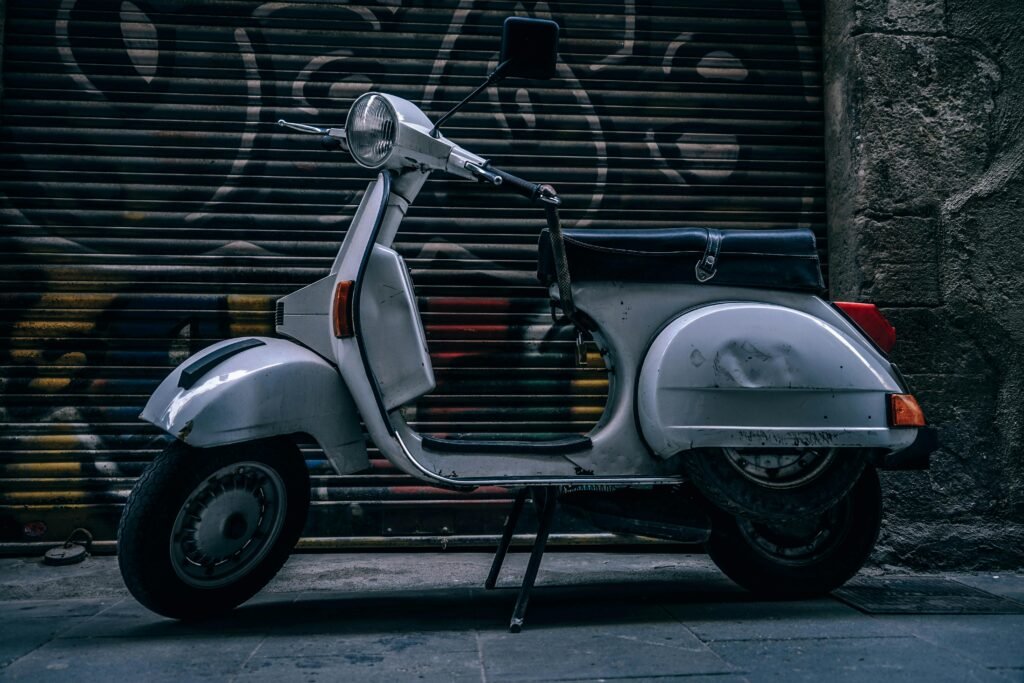
Imagine yourself gliding effortlessly down the streets, cruising on a sleek and nimble scooter, the envy of onlookers. The key to this exhilarating experience lies in mastering the art of balancing on a scooter. With a few simple yet essential techniques, you can unlock the joy of smoothly maneuvering through the city, feeling the wind on your face, and the freedom that comes from perfect equilibrium. Whether you’re a beginner or an experienced rider, this article will guide you through the steps to achieve stability, grace, and confidence on a scooter, making every ride a thrilling adventure.

This image is property of images.pexels.com.
Check out our product reviews!
Choosing the Right Scooter
When it comes to balancing on a scooter, choosing the right one is crucial. Consider the type of scooter that best suits your needs. There are various types, such as kick scooters, electric scooters, and stunt scooters. Each type offers different features and specifications, so make sure to pick one that aligns with your preferences and skill level.
Another important factor to consider is the scooter’s weight limit. It’s essential to choose a scooter that can support your weight to ensure both your safety and the scooter’s performance. Check the manufacturer’s specifications to determine the maximum weight capacity of the scooter you’re interested in.
In addition, ensure that the scooter has a stable base. Look for a scooter with a wide and sturdy platform to provide better stability while balancing. A stable base will give you the confidence and support you need to master the art of balancing on a scooter.
Lastly, opt for a scooter with adjustable height. Being able to adjust the height of the handlebars allows for a more personalized and comfortable riding experience. It’s important to have the proper posture while balancing, and adjustable handlebars can help you achieve that.
Wearing the Right Gear
To ensure your safety while balancing on a scooter, wearing the right gear is essential. Start with a properly fitting helmet that protects your head in case of falls or accidents. Make sure the helmet is snug but not too tight, providing adequate protection without discomfort.
In addition to a helmet, use knee and elbow pads for protection. These protective gear pieces minimize the risk of injuries to these vulnerable areas in case of falls or collisions. They provide an extra layer of cushioning and support to prevent scrapes, cuts, and bruises.
Wrist guards are another crucial gear item when it comes to balancing on a scooter. They protect your wrists from injuries and provide stability while riding. The wrist guards should fit securely but still allow for comfortable movement of your hands.
Lastly, consider wearing non-slip shoes for better grip on the scooter’s platform. Look for shoes with good traction to prevent your feet from slipping during balancing maneuvers. This will enhance your stability and control over the scooter, reducing the risk of accidents or losing balance.

This image is property of images.pexels.com.
Check out our product reviews!
Starting with Balance Exercises
Before diving into the world of scooter balancing, it’s important to start with some balance exercises to build a solid foundation. These exercises will help improve your overall stability and control while riding a scooter.
To begin, practice standing with one foot on the ground and the other foot slightly lifted. This exercise will help you get accustomed to balancing on one leg and develop a sense of proprioception. Try to maintain your balance for as long as possible, gradually increasing the duration as you become more comfortable.
Next, move on to balancing on one foot at a time. Lift one foot off the ground and try to maintain your balance while keeping the other foot firmly planted. Start with shorter durations and gradually increase as you gain confidence.
As you progress, challenge yourself by shifting your weight from one foot to the other while maintaining balance. This exercise will simulate the movements you’ll be making while riding a scooter and help you develop better coordination and control.
Once you feel comfortable with static balancing, practice balancing while moving in a straight line. Start by taking small steps forward and gradually increase the distance. Focus on keeping your balance and maintaining a smooth and steady motion.
Learning the Proper Posture
Maintaining the proper posture is key to balancing on a scooter effectively. Start by keeping your back straight while riding. Slouching or leaning forward can throw off your balance and make it harder to control the scooter.
Align your body with the scooter’s center. This means standing in the middle of the platform and distributing your weight evenly on both feet. This balanced position will give you better stability and control over the scooter.
Bend your knees slightly for added stability. Having a slight bend in your knees allows for better shock absorption and helps you maintain balance even on uneven terrain. Keep your knees relaxed and avoid locking them, as this can make it harder to adjust to sudden movements or changes in the surface.
While balancing, direct your gaze forward, not down. Looking forward helps you anticipate any obstacles or potential hazards, allowing you to react quickly and maintain a steady balance. Focusing on the path ahead will also help you improve your overall riding skills and avoid accidents.

This image is property of images.pexels.com.
Using Your Arms for Balance
Your arms play a crucial role in maintaining balance while riding a scooter. Extend your arms slightly for better stability. Having your arms stretched out to the sides can help counterbalance your body and keep you centered.
Use your arms to counterbalance any shifts in your body weight. If you lean to one side, use your arms to compensate and regain balance. This movement will help you maintain stability and prevent falls or accidents.
Keep your arms relaxed and slightly bent. Tense or straightened arms can make it harder to make quick adjustments or respond to changes in your balance. By keeping your arms relaxed, you allow for more fluid movements and better control over the scooter.
Avoid excessive arm movements while riding. Flailing your arms or making wide gestures can throw off your balance and make it harder to maintain stability. Instead, focus on small, controlled arm movements that contribute to your overall balance and control.
Finding the Right Foot Placement
Proper foot placement is crucial for maintaining balance and control while riding a scooter. Start by placing your feet shoulder-width apart on the scooter’s platform. This wide stance provides a stable base and enhances your overall balance.
Position your dominant foot slightly forward. If you’re right-footed, have your right foot slightly in front of the left foot, and vice versa. This placement allows for better control and stability, as the dominant foot can initiate movements more effectively.
Grip the scooter’s handlebars firmly but avoid excessive tension in your hands. A relaxed grip will prevent fatigue and allow for better maneuverability. Your hands should provide support and control without being too rigid.
Keep your toes pointed forward while riding. This position helps you maintain better balance and control. Avoid pointing your toes outward or inward, as it can affect your stability and make it harder to control the scooter.
Starting with Small Scooter Movements
When you’re ready to start balancing on a scooter, begin with small movements to gain momentum and confidence. Start by pushing off gently with one foot and let the scooter roll a short distance. This motion will help you get accustomed to the scooter’s movement and improve your balance.
Gradually increase your speed as you become more comfortable with the scooter’s motion. Push off with more force, allowing the scooter to travel a little farther each time. Focus on maintaining your balance and posture as you increase your speed. The key is to start slow and build up gradually to avoid feeling overwhelmed or losing control.
Control your scooter using smooth and gentle movements. Avoid jerky or sudden maneuvers, as they can throw off your balance and potentially lead to falls or accidents. Practice maintaining a steady pace and smooth transitions between movements, gradually increasing your confidence and control.
Maintaining an Inner Core Balance
Apart from external factors like gear and posture, developing a strong inner core is essential for maintaining balance on a scooter. Engaging your core muscles provides stability and control, allowing you to make precise movements and adjustments while riding.
Practice abdominal and balance exercises to strengthen your core muscles. Exercises like planks, side planks, and Russian twists can help improve your core strength and stability. A strong core will make it easier to control your movements and maintain balance on the scooter.
Focus on maintaining a strong center throughout your rides. By connecting to your core and activating those muscles, you’ll have a better sense of balance and control. This connection will allow you to efficiently transfer your body weight and make adjustments while riding.
Control your movements from your core. Instead of relying solely on your arms or legs, focus on initiating movements from your center. This approach will help you maintain better overall balance and stability while riding a scooter.
Improving Balance through Practice
Like any skill, balancing on a scooter requires practice and dedication. Incorporate regular practice sessions into your routine to improve your balance skills. Start with short sessions focusing on specific aspects of balancing, gradually increasing the difficulty and duration as you progress.
Consistency is key when it comes to mastering balancing skills. Devote regular time to practice your scooter balance exercises and techniques. Even a few minutes each day can make a significant difference in your progress and help you build confidence.
As you become more comfortable with the basics, challenge yourself with different terrains. Practice balancing on various surfaces like pavement, gravel, or grass. Each terrain presents unique challenges and requires different levels of balance and control. By exposing yourself to different environments, you’ll become a more adaptable and skilled rider.
Seeking Professional Guidance
If you’re serious about mastering the art of balancing on a scooter, consider seeking professional guidance. Taking scooter balance lessons from a qualified instructor or coach can significantly accelerate your progress and ensure you develop proper techniques.
Find a qualified instructor or coach who specializes in scooter balancing. They will have the expertise and knowledge to guide you through the learning process and provide personalized feedback. Their guidance will help you overcome challenges and develop advanced balancing techniques.
By receiving personalized guidance, you’ll be able to identify and correct any mistakes or shortcomings in your technique. Professional instruction can help you refine your skills and take your balancing abilities to the next level.
In conclusion, mastering the art of balancing on a scooter requires time, patience, and proper technique. Choose the right scooter, wear the appropriate gear, and practice various exercises to improve your balance. Focus on maintaining the proper posture, using your arms for balance, and finding the right foot placement. Start with small movements, maintain core stability, and practice regularly to continually improve. If needed, seek professional guidance to enhance your skills and learn advanced balancing techniques. With dedication and practice, you’ll become a confident and skilled scooter rider.



